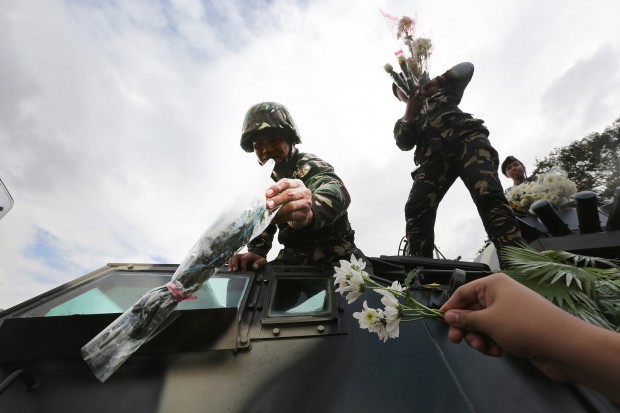
FLOWER POWER Soldiers on an armored vehicle receive flowers from civilians taking part in the commemoration of the 30th anniversary of the Edsa People Power Revolution on Thursday, in a reenactment of the peaceful uprising in 1986. JOAN BONDOC
“THE QUESTION is, if that was your Edsa then, what is our Edsa now?,” youth leader Ma. Angela Magay-Villa asked during the celebration of the 30th anniversary of the revolution at the People Power Monument on Thursday.
Another youth leader, Khenn Arquiza of the Zamboanga-based nongovernment organization, I CAN Make a Difference, joined President Aquino and former President Fidel V. Ramos during the event that saw Ramos, a major Edsa player, reprise his famous jump twice to recall the historic moment when rebel troops joined forces during the four-day holdout at Camp Crame.
The two-hour program also showcased the Philippine Air Force’s newest assets, including two supersonic fighter jets that executed a high-speed opener pass over a crowd that numbered about 6,000, according to official estimates.
Fifteen light military trainer jets also flew in formation, trailing blue, red and yellow smoke behind them, followed by several helicopters, two of which showered the area with yellow and white confetti.
Performances by Noel Cabangon, Ogie Alcasid and the Ryan Cayabyab singers enlivened the celebration, while some 2,000 personnel from the Armed Forces of the Philippines and the Philippine National Police, as well as tanks, recreated the scene for the mainly civilian crowd.
‘Guide us’
Seated beside Mr. Aquino was Liberal Party standard-bearer Mar Roxas, Executive Secretary Paquito Ochoa Jr., Speaker Feliciano Belmonte Jr. and Defense Secretary Voltaire Gazmin. Also onstage was Jim Paredes, one of the artists behind the People Power anthem, “Handog ng Pilipino sa Mundo.”
Addressing the Edsa veterans in the crowd, Villa said: “As we forge this path of our own Edsa, we ask you to guide and teach us, to trust us. Because we are the new hope, we will continue this new revolution. We are the new Edsa.”
For millennials
Ochoa said this year’s celebration was meant for the millennials, with the People Power Experiential Museum set up inside Camp Aguinaldo meant to “awaken them to value the freedoms most of us take for granted.”
He added: “The challenge to our generation was to restore democracy. The challenge to your generation is to enrich and improve the democracy you enjoy now.”
Among the players of the 1986 Edsa People Power Revolution seen at the 30th anniversary was Sr. Porferia “Ping” Ocariza, who said that the four-day Edsa struggle gave the country the “seed” of de mocracy, and that “the youth should continue to grow and nurture it.”
An Ateneo de Manila University student, Marc Duque, said that despite the contrary views of some millennials about Edsa, it was important to engage rather than exclude them “because we can learn something from them. What is their current condition that makes them say that we should return to martial law?”
If students were to tell him that martial law was the country’s “golden age,” a 61-year-old social studies professor and Edsa veteran, Florencio Puerto Jr., said he would tell them that many Filipinos lost their parents, siblings and loved ones during that time.
Cesar Sarino of the Edsa People Power Commission said the museum could fill in the youth with information about what “people went through” during the Marcos rule.
He said there were plans to move the museum after today’s exhibit, to Quezon City where it would stay for two years. Hopefully, a more permanent museum at the back of the People Power Monument could be put up, “where students can have tours and learn and understand what sparked the Edsa revolution,” Sarino added.